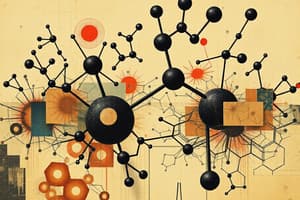Podcast
Questions and Answers
Which class of large biological molecules includes carbohydrates, lipids, proteins, and nucleic acids?
Which class of large biological molecules includes carbohydrates, lipids, proteins, and nucleic acids?
- Carbohydrates
- Macromolecules (correct)
- Lipids
- Proteins
What is the monomer of carbohydrates?
What is the monomer of carbohydrates?
Monosaccharides
What is the linkage that forms between the monomers of carbohydrates?
What is the linkage that forms between the monomers of carbohydrates?
Glycosidic linkage
What is the stored form of carbohydrates in humans and animals?
What is the stored form of carbohydrates in humans and animals?
Which of the following is a type of polysaccharide?
Which of the following is a type of polysaccharide?
Lipids are formed through polymerization.
Lipids are formed through polymerization.
What is the general formula for carbohydrates?
What is the general formula for carbohydrates?
Which monosaccharide is known as an important source of energy in humans?
Which monosaccharide is known as an important source of energy in humans?
What type of reaction forms macromolecules from monomers?
What type of reaction forms macromolecules from monomers?
What is the primary storage form of carbohydrates in plants?
What is the primary storage form of carbohydrates in plants?
What type of linkage occurs between two monosaccharides to form disaccharides?
What type of linkage occurs between two monosaccharides to form disaccharides?
Study Notes
Macromolecules
- Living organisms are composed of four main classes of macromolecules: carbohydrates, lipids, proteins, and nucleic acids.
- Macromolecules are large molecules comprised of thousands of covalently bonded atoms.
- Structure and function are inextricably linked for macromolecules.
Polymers
- Polymers are large molecules consisting of repeating units called monomers.
- Monomers are the small building blocks of polymers.
Dehydration and Hydrolysis Reactions
- Dehydration reactions are condensation reactions that form macromolecules.
- Two monomers bond together via the loss of a water molecule during a dehydration reaction.
- Hydrolysis reactions break down polymers into monomers.
- Water is added during hydrolysis leading to the lysis of polymers.
Carbohydrates
- Carbohydrates are organic compounds composed of carbon, hydrogen, and oxygen.
- These compounds have a general formula of CnH2mOm.
- The hydrogen and oxygen atoms are present in a ratio of 2:1.
- Examples include glucose (C6H12O6) and sucrose (C12H22O11).
Monosaccharides
- Monosaccharides are also known as simple sugars.
- Mono means "single" and saccharides means "sugar."
- Monosaccharides are a major cellular nutrient, often incorporated into more complex carbohydrates.
Glucose
- Glucose is an important energy source for humans.
- It is a product of photosynthesis and the substrate for respiration, providing energy.
Fructose
- Fructose is found in many plants, fruits, and is often bonded to glucose.
Galactose
- Galactose is a component of lactose, or milk sugar.
Disaccharides
- Disaccharides are formed when a glycosidic linkage occurs between two monosaccharides.
- They serve as energy sources, sweeteners, and dietary components.
Maltose
- Maltose is composed of glucose + glucose.
- It's often found in sprouting grains, malt-based energy drinks, or beer.
Lactose
- Lactose is composed of glucose + galactose.
- Milk sugar, a source of energy for infants.
Sucrose
- Sucrose is composed of glucose + fructose.
- Found in table sugar processed from sugarcane, sweet fruits, and storage roots like carrots.
Polysaccharides
- Polysaccharides are formed when hundreds to thousands of monosaccharides are joined by glycosidic linkages.
- They serve as storage material for important monosaccharides and structural material for the cell or organism.
Starch
- Starch is found in plant parts like potato tubers, corn, and rice, serving as a major energy source.
Glycogen
- Glycogen is found in animals and fungi, often in liver cells and muscle cells.
Cellulose
- Cellulose forms tough sheet-like structures making up plants, which can be processed to form paper-based products.
Chitin
- Chitin serves as structural support in fungal walls and the external skeletons of arthropods.
Peptidoglycan
- Peptidoglycan provides structural support in bacterial cell walls.
Lipids
- Lipids are a class of large biomolecules that are not formed through polymerization.
- They have diverse structures and functions.
Studying That Suits You
Use AI to generate personalized quizzes and flashcards to suit your learning preferences.
Related Documents
Description
Test your knowledge about macromolecules, their structures, functions, and the key processes involved in their formation and breakdown. This quiz covers carbohydrates, polymers, and the reactions of dehydration and hydrolysis. Challenge your understanding of the building blocks of life!



